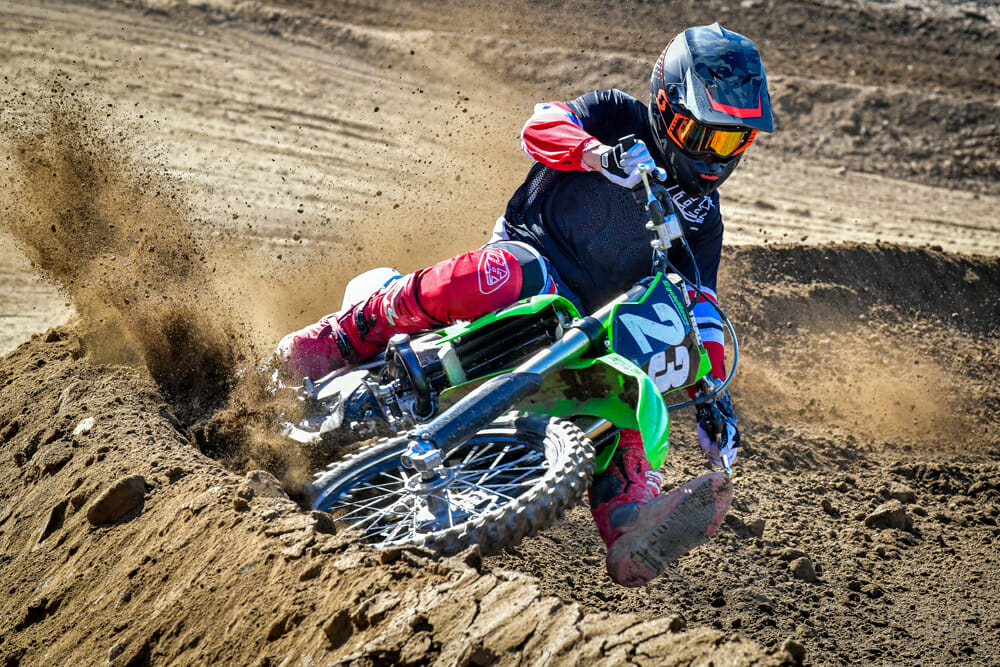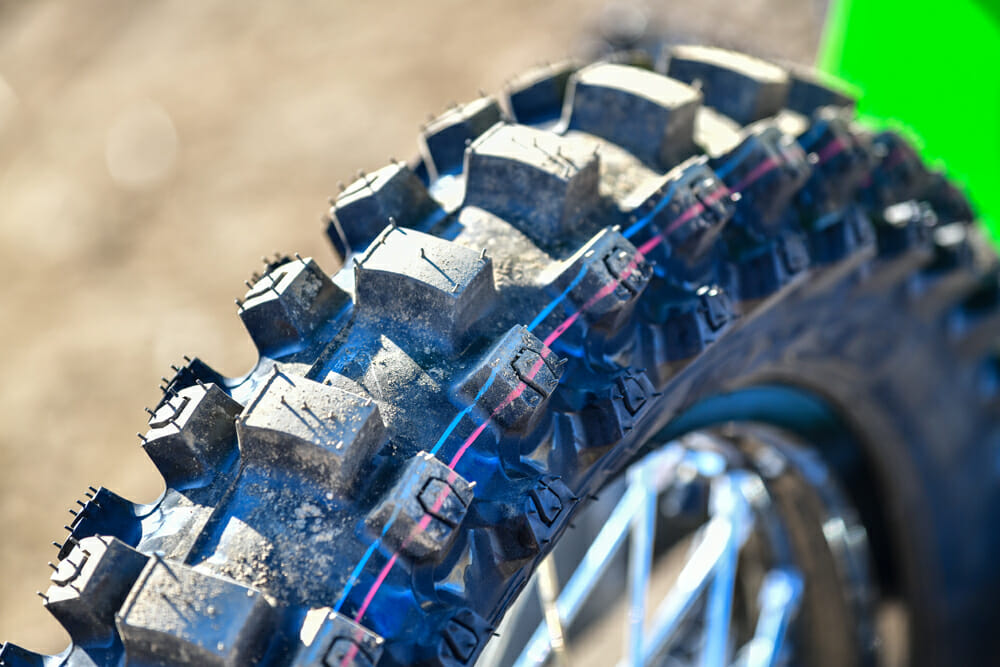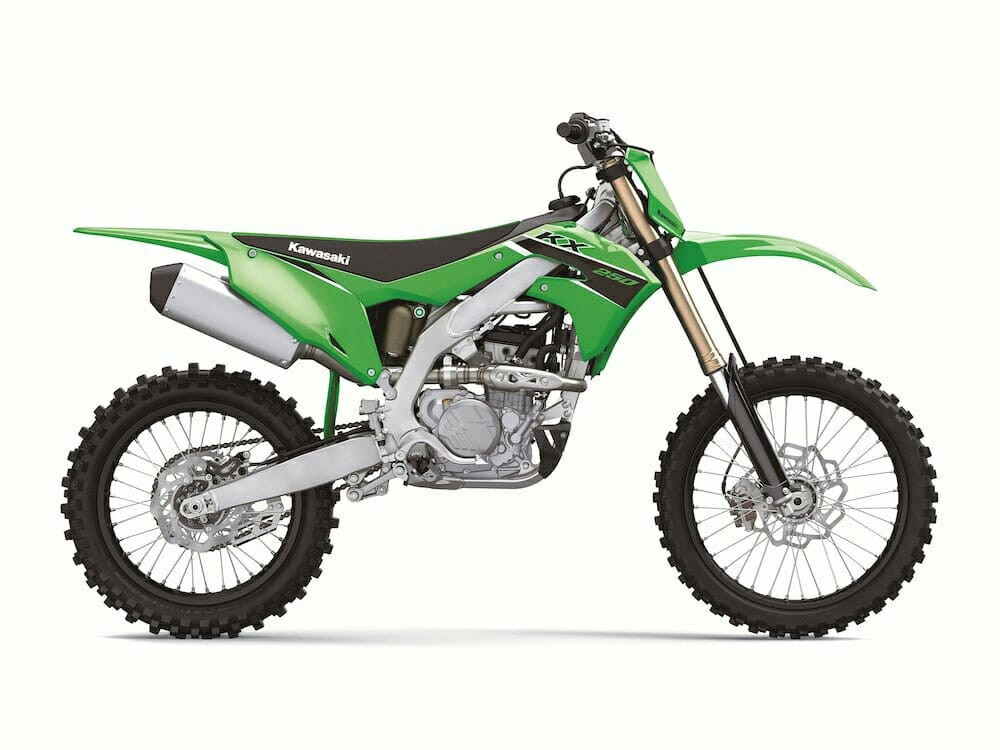Ryan Nitzen | September 22, 2022
New bike season is officially here, and the 2023 Kawasaki KX250 returns with several key updates. This bike was completely redesigned in 2021 and now enters the third year of its current generation.

Photography by Kit Palmer
For 2023, the Team Green engineers focused on the engine. As a result, the ’23 KX250 receives a whole host of internal changes to increase power and improve overall rideability.
Highlighting some of the engine changes are a longer exhaust header, a new and straighter downdraft intake duct and a repositioned injector in the throttle valve. The KX uses a dual injector system, and the second upstream injector (the one closest to the airbox) has been relocated from the top of the air intake to the bottom for a more efficient shot of fuel into the engine. This injector—opposed to the downstream injector, which is closer to the combustion chamber—handles high rpm duties. (The downstream injector’s role is low rpm.)
 It might look the same on the outside but there’s a host of changes inside.
It might look the same on the outside but there’s a host of changes inside.
A new head uses smaller valves with a different pitch to improve torque. Mapping is new, and there is a heavier magneto rotor.
These engine changes allowed for taller first- and second-gear ratios, so now you can wait a little longer before shifting in the first few gears. Less shifting is always a good thing.
Not much has changed with suspension. The KYB fork rolls off the showroom floor with a bit more compression damping.
Externally, the ’23 KX250 gets 5mm wider footpegs—which are also slightly repositioned due to new aluminum brackets—and new Dunlop MX33 tires—the rear is fitted onto a wider 110/90-19-inch rim versus the previous 100/90 rim.
As you can see, the 2023 KX250 might not fall into the “all-new” category, but it still got a healthy dose of changes for a mid-generation bike.
 Engine updates offer better carry in all rpm ranges making the new KX250 easier to ride.
Engine updates offer better carry in all rpm ranges making the new KX250 easier to ride.
Can You Feel It?
Yes. On the track, you can instantly feel these new updates. Our introductory ride on the bike took place at Southern California’s Perris Raceway, and the engine, of course, is what stood out the most. In recent years, the KX250 has never been criticized for lacking top-end pull, but bottom-end has never been considered a strong point. But it’s now getting there.
The ’23’s updated engine results in a hearty pop off the bottom and carries a nice transition through the midrange of the power. That feeling continues from the mid to top-end, and the bike doesn’t require a bunch of intermittent shifts to get you from section to section. Instead, gears two and three seem much longer and more usable. I still count gears when I ride, and, on one particular Perris jump, I could now hit it in second gear, something I could usually only do on a 450. Most 250s force me to grab third gear on the face of this jump, but the KX250 provides a noticeably strong pull from the bottom to the top of the rpm range, so I didn’t have to shift so much. Grabbing a gear midair is easier than doing it on the lead-up to a jump, and simple nuances like this make the KX250 much easier to ride as you link sections of the track together.
VIDEO | 2023 Kawasaki KX250 Review
The bike still has three plug-in coupler options: rich, standard and lean. Or if you will: smooth, standard and aggressive. Being somewhat big for a 250, I usually opt for the most aggressive option on 250Fs. However, the combination of the Kawi’s new mapping, engine mods, and gearing gave the bike a little extra on top while still offering improved bottom-end pop, which changed things up a bit. A rutted track like Perris usually requires the rider to use the most inside rut, and low-end pull is a near necessity for these fast lines. Forgoing that extra grunt off the bottom with the aggressive coupler, however, just didn’t suit this style track, so I preferred the standard coupler because it provided the best overall power and usability.
 A longer header pipe and several internal engine updates reward the rider with better bottom-end and improved rideability.
A longer header pipe and several internal engine updates reward the rider with better bottom-end and improved rideability.
In the suspension department, Kawasaki now recommends 100mm (instead of 105mm) of sag out back to balance out the stiffer fork settings. The bike does indeed feel firmer which worked out well for me on the jumpy Perris track. I did back out the fork’s compression by two clicks (softer) at first but later returned to the stock settings. The standard settings felt suitable for my 180 pounds for Perris’ deeply rutted and jump-ridden layout. However, faster and rougher tracks might not yield the same result, especially with the rear end sitting up a touch higher than it used to with Kawasaki’s new recommended settings. More time on the bike will tell.
 The KX250 comes fitted with Dunlop MX33 tires, and the rear tire now mounts up to a wider rim.
The KX250 comes fitted with Dunlop MX33 tires, and the rear tire now mounts up to a wider rim.
A hydraulic clutch still comes standard on the KX250. They’ve updated the pushrod material, and it feels solid. It has clear engagement and good modulation for a hydraulic setup, and I never noticed any fade during our test day. No complaints in this department are equal to an “A-plus,” as far as I’m concerned.
Ergos are about as standard as they come. The KX250 feels like your typical Japanese motocrosser and is probably most equivalent to a Suzuki or Honda. Team Green equip their bikes with its Ergo-Fit system, which, in this case, allows users to adjust the handlebar mount fore and aft and the footpegs down one position from standard. At 6’1,” I prefer to run the KX’s bars closer to me while leaving the footpegs where they come from the factory. The wider footpegs offered a solid platform for my size 11 boots and gave me that welcomed aftermarket feel.
 The KYB fork is set up from the factory with more compression damping
The KYB fork is set up from the factory with more compression damping
If I owned this bike, I’d make a few quick changes, however. For one, I’d ditch the handlebar levers right away. The KX’s sharp blade-style lever was introduced on the 2019 KX450 and has come on every motocross model since. I’m not a fan, and I think most people aren’t. In short, do yourself a favor and have your dealer throw in a set of aftermarket levers on your way out the door. Secondly, the exhaust. There’s nothing technically “wrong” with the stock exhaust system; it’s just overly loud for my liking. I’d seek out a quieter slip-on muffler. Until then, a pair of earplugs will have to do.
 Once again, the KX250 serves as a strong platform for racers.
Once again, the KX250 serves as a strong platform for racers.
Key changes to the latest KX are making this bike even more desirable than it already was. While the bike isn’t all-new by any means, it is an improvement over the previous model. Kawasaki’s engineers are showing that they aren’t taking a back seat regarding mid-generation updates. The bike is stronger and overall easier to ride than it was just one year ago. As more and more 250cc four-strokes move towards torquier engine characteristics, it’s clear that Kawasaki is putting brands like Yamaha and Honda directly in the crosshairs. CN

2023 Kawasaki KX250 Specifications
| MSRP: |
$8499 |
| Engine: |
4-stroke, single |
| Cooling System: |
Liquid |
| Valvetrain: |
DOHC, 4-valve |
| Bore x Stroke: |
78.0 x 52.2mm |
| Compression Ratio: |
14.1:1 |
| Fuel System: |
DFI w/44mm Keihin throttle body, dual injectors |
| Ignition: |
Digital CDI |
| Transmission: |
5-speed |
| Clutch: |
Wet, multi-disc, hydraulically operated |
| Frame: |
Aluminum, perimeter |
| Front Suspension: |
48mm inverted telescopic fork, coil-spring, fully adjustable |
| Rear Suspension: |
Single shock Uni-Trak, fully adjustable |
| Front-Wheel Travel: |
12.4 in. |
| Rear-Wheel Travel: |
12.4 in. |
| Front Tire: |
80/100 x 21 in. Dunlop MX33 |
| Rear Tire: |
110/90 x 19 in. Dunlop MX33 |
| Front Brake: |
Single semi-floating 270mm Braking petal disc w/ dual-piston caliper |
| Rear Brake: |
Single 240mm Braking petal disc w/ single-piston caliper |
| Rake / Trail: |
28.0° / 4.6 in. |
| Ground Clearance: |
13.6 in. |
| Wheelbase: |
58.5 in. |
| Seat Height: |
37.8 in. |
| Weight (dry, claimed): |
227.6 lbs. |
| Fuel Capacity: |
1.64 gal. |

Click here to read the 2023 Kawasaki KX250 Review in the Cycle News Digital Edition Magazine.